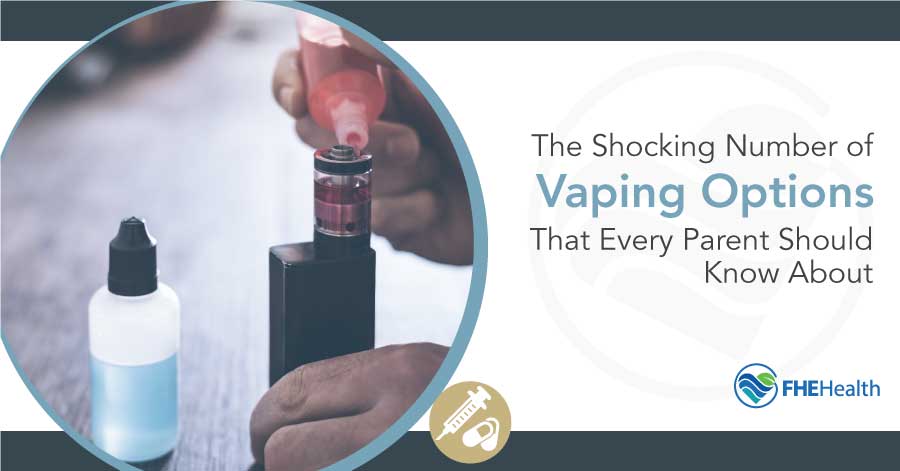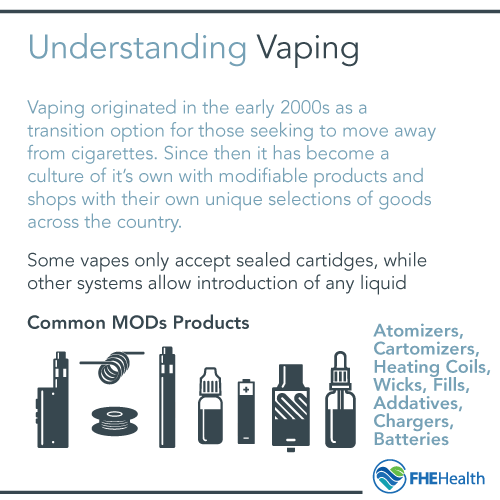
The popularity of vaping is well-known. A deviation of the original electronic cigarettes, vapes are now ubiquitous— with an estimated 10.8 million Americans using electronic cigarettes of some sort, over half of them under the age of 35.
Just as parents for hundreds of years have had to contend with their children smoking, today’s parents can also add vaping to the list. While propagated as a better alternative to smoking, vaping isn’t a healthy habit, and it’s certainly not a good thing for children. However, this doesn’t mean kids aren’t doing it — nearly 40 percent of 12th graders admitted to vaping at least once in the last 12 months.
For any parent who is largely unfamiliar with vaping culture, it’s therefore important to understand the reality of the behaviors in which their children are partaking, particularly if these behaviors are dangerous. This is what you need to know about the shocking number of vaping options available to your children.
What Is Vaping and Why Is it Popular?
 While the idea behind electronic cigarettes has existed for nearly a century, the modern e-cigarette did not become popular until the early 2000s. Similar in size and appearance to regular cigarettes, these devices consisted simply of a cartomizer and a battery and were intended specifically for those who wanted to break the habit of smoking toxic and dangerous, dried tobacco cigarettes.
While the idea behind electronic cigarettes has existed for nearly a century, the modern e-cigarette did not become popular until the early 2000s. Similar in size and appearance to regular cigarettes, these devices consisted simply of a cartomizer and a battery and were intended specifically for those who wanted to break the habit of smoking toxic and dangerous, dried tobacco cigarettes.
However, as the concept took off, manufacturers deviated from the style of a traditional e-cigarette, with the goal of turning vaping into a unique activity separate from cigarette smoking. This change led to the more technologically advanced vape pens that are popular today.
Modern vape pens contain cartridges that allow for a wide variety of e-liquids, generally using propylene glycol as a base. These make use of numerous flavors, nicotine concentrations and intoxicating side effects. Some e-liquids do not contain any nicotine at all. This allows for a step-down approach for those who are trying to quit smoking or a pleasurable experience for those who do not vape for the purpose of consuming nicotine.
Mods also allow for customization of the vaping process. These kinds of additions include tanks, which improve capacity and offer the ability to control airflow, and coils, which allow for a customizable temperature. Vapes can be purchased as-is from manufacturers, modified independently or constructed piece by piece by a user.
JUULs
Vape pens exist under numerous brand names, but JUULs are by far the best known and the most popular with high school students and college students nationwide. Considered an alternative to a cigarette or vaping product (standard vape pens and e-cigarettes), JUUL devices use cartridges containing oils that can be vaporized in flavors like creme brulee and mango. Each cartridge contains the same amount of nicotine as a pack of cigarettes.
This is particularly concerning for parents, as nicotine has been demonstrated to affect brain development in adolescents. Studies also indicate that most teens do not realize they are consuming nicotine when using JUULs or other vaping devices. Many teen users believe that the liquid contained in cartridges is simply flavored oils.
Illegal Substances and Vaping
For most vape users, consuming nicotine is the primary objective. However, it is very possible to smoke other non-nicotine substances via vape pens.
For parents of children vaping, the distinctions between legal nicotine substances and other alternatives are very important. Even if you believe your child is vaping nicotine, they may actually be using illicit drugs.
While nicotine is still by far the most common substance used in e-liquid, other options include:
- THC oil, the ingredient that generates a high when smoking marijuana
- Bath salts, a form of synthetic stimulant
- Hash oil
- Synthetic marijuana, like K2 or Spice
- Psychedelics
- CBD
This kind of usage is most common among teens, particularly those who want to consume drugs inconspicuously through the use of legal devices. If you believe your teen is using nicotine, they may be, or they may be using harder substances under the guise of standard vaping.
Smoking Wax, Shatter and Dabs
In addition to liquid, vape pens also allow for the consumption of a wax-like solution that contains marijuana. Smoking shatter or a similar concentrate generally involves using a separate device called a wax or dab pen. Options for these kinds of pens include:
- Shatter, a glass-like substance containing high levels of THC
- Crumble, a dried concentrate easy to pack into a pen
- Budder, a thick paste-like substance
- Wax, a sticky substance ideal for use in a dab pen
Once properly packed into a pen, heating coils essentially vaporize these substances, using hot air to extract the chemical compounds that provide a high and allowing for easy inhalation. This can be done using combustion or conduction heating devices.
Parents should be familiar with the concept of dabbing— and not the dance move. As dabs are one of the currently most popular and easiest ways to consume marijuana, usage is exceedingly common among teens and young adults. In addition to rolling papers and marijuana leaves, parents should also look for pens as evidence that their children are using drugs.
CBD Oil
CBD oil is rapidly growing in popularity with users embracing the nonintoxicating properties of marijuana to target everything from cancer to pain. While the clinical usefulness is still under study, CBD is legal for adults on a federal level, although state laws are quite varied.
Research does not currently indicate any long-term negative ramifications, and CBD does not provide a high like THC does. However, its efficacy is still questionable, and it is not encouraged for teens or children.
The Dangers of Smoking via Vape
Smoking is never safe, and that includes vaping. Nicotine can be harmful to adolescents, creating the potential for health problems in those who choose to vape nicotine at a young age.
Nicotine can also raise heart rate and increase the likelihood of a heart attack at any age. Devices like the popular JUUL contain far higher levels of nicotine than normal cigarettes, increasing the risks.
As the modern method of vaping is still rather new, long-term health risks and lung injuries are yet unknown. However, it is likely that the ingredients used to make e-juice and the flavorings within them may have harmful chemicals that could cause hold the potentially for dangerous side effects.
Is Vaping Addictive?
The short answer? Yes. Vaping generally uses nicotine or marijuana products, both of which are addictive in all quantities. In fact, as products like JUUL pens contain even more nicotine than is standard, these can be even more addictive than traditional cigarettes.
Public health officials are deeply disturbed by this trend; even as smoking rates have declined on a national level, vaping rates are increasing, leading to higher nicotine addiction rates among young people.
The process of smoking anything can also be addictive. The routine of enjoying a cigarette is, for many people, a part of the attraction, and this can be true for vaping as well.
Legislation and Vaping
As vape pens are relatively new on the scene, not all states have regulations regarding vaping. While virtually all states, save for Michigan, have some sort of legislation on the books that refers to vaping, the extent of this can vary greatly.
In 16 states, e-cigarettes are classified and sold as tobacco products while 10 states have vice tax rules involving vaping products. A majority of states do regulate product packaging of e-cigarettes, and all states except Michigan and Pennsylvania require purchasers to be either 18 or 21.
It’s important to note that these laws specifically apply to vape pens used to smoke tobacco products containing nicotine. Smoking marijuana out of vape pens is more variable and depends on the state law in question.
Marijuana is still illegal on a federal level. In states where marijuana is legal, vaping marijuana may be permitted as long as dispensaries sell products that can be vaped. Growing marijuana or producing dabs recreationally may still be illegal.
Among teens, vaping is a new and troublesome concern, leading to a heightened level of nicotine addiction. As a parent, it’s important to know the dangers of vaping and the warning signs to ensure your child isn’t at risk for health problems or addiction.
If you or someone you love is addicted to drugs or alcohol, the right treatment is imperative. Please contact FHE Health today to learn more about our comprehensive rehabilitation opportunities.






